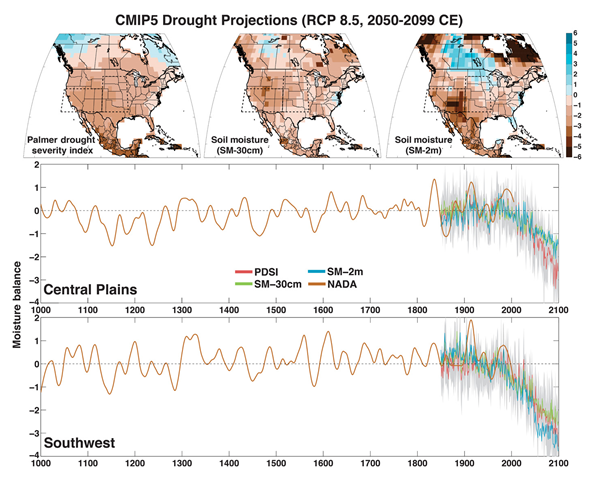If you think that California is dry now, wait until mid-century – ‘We haven’t seen anything like this since at least the 1400s’
By Eric Holthaus
12 February 2015 (Slate) – When it comes to drought in the West, we ain’t seen nothin’ yet. That’s the conclusion from a new study that links an increasing risk of decades-long drought episodes in the western United States to human-induced climate change. The study predicts drought severity outside the bounds of what’s thought to have occurred over the past 1,000 years, based on local tree-ring records. “It’s certainly not good news,” said co-author Jason Smerdon, a climate scientist at Columbia University’s Lamont-Doherty Earth Observatory. The study was published Thursday in the inaugural issue of Science Advances, an open-access journal from AAAS, the same publisher as Science. Smerdon’s study is the first to examine the future risk of “megadrought” in the southwest and central United States in the context of historical episodes of drought in the same regions. Smerdon’s study suggests that the coming years are likely to see droughts worse than the epic dry periods that are thought to have caused profound changes to human settlement in the region over the last millennium. “They’re ‘mega’ because they are droughts that lasted in these regions for multiple decades,” said Smerdon in an interview with Slate. “We haven’t seen anything like this since at least the 1400s.” In comparison, the current California drought is four years old, though drought has been present in most of the last 15 years somewhere in the West. [more]
The United States of Megadrought
ABSTRACT: In the Southwest and Central Plains of Western North America, climate change is expected to increase drought severity in the coming decades. These regions nevertheless experienced extended Medieval-era droughts that were more persistent than any historical event, providing crucial targets in the paleoclimate record for benchmarking the severity of future drought risks. We use an empirical drought reconstruction and three soil moisture metrics from 17 state-of-the-art general circulation models to show that these models project significantly drier conditions in the later half of the 21st century compared to the 20th century and earlier paleoclimatic intervals. This desiccation is consistent across most of the models and moisture balance variables, indicating a coherent and robust drying response to warming despite the diversity of models and metrics analyzed. Notably, future drought risk will likely exceed even the driest centuries of the Medieval Climate Anomaly (1100–1300 CE) in both moderate (RCP 4.5) and high (RCP 8.5) future emissions scenarios, leading to unprecedented drought conditions during the last millennium.
Unprecedented 21st century drought risk in the American Southwest and Central Plains
